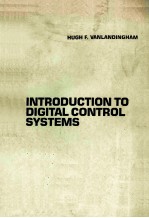

INTRODUCTION TO DIGITAL CONTROL SYSTEMSPDF电子书下载
- 电子书积分:15 积分如何计算积分?
- 作 者:
- 出 版 社:MACMILLAN PUBLISHING COMPANY
- 出版年份:1985
- ISBN:0024226106
- 页数:460 页
Ⅰ MODELING AND ANALYSIS OF DISCRETE-TIME SYSTEMS 3
1 INTRODUCTION TO DIGITAL CONTROL 3
1.1 Basic system concepts and classification 4
1.2 Feedback systems and digital control 9
1.3 Sampling and reconstruction of signals 12
1.4 Computer interfacing 16
1.5 Discrete-time system response 21
1.6 Convolution of sequences 24
1.7 Linear difference equations 26
1.8 Solved Problems 30
1.9 Summary and references 35
Problems 35
2 TRANSFORM ANALYSIS 39
2.1 Introduction to z-transforms 39
2.2 Basic z-transform properties 45
2.3 Inverse transform techniques 51
2.4 Pulse transfer functions 59
2.5 Block diagrams and signal-flow graphs 64
2.6 Response from z-domain functions 71
2.7 A stability test for linear discrete-time systems 77
2.8 Solved problems 80
2.9 Summary and references 88
Problems 89
3 STATE-VARIABLE ANALYSIS FOR DISCRETE-TIME SYSTEMS 95
3.1 Introduction to discrete-time state variables 96
3.2 State variables for continuous-time systems 99
3.3 General solution for the continuous-time state model 101
3.4 Discrete-time state models for sampled-data systems 103
3.5 System response by recursion 107
3.6 State models from difference equations 109
3.7 Equivalent state models and multivariable systems 116
3.8 Discrete-time system stability 122
3.9 Solved problems 127
3.10 Summary and references 137
Problems 138
4 SYSTEM SIMULATION TECHNIQUES 145
4.1 Machine calculation of the transition matrices 146
4.2 Digital filter techniques 150
4.3 Homogenous equivalent systems 166
4.4 Discrete-time system simulation 168
4.5 Simulation of digital control systems 170
4.6 Solved problems 176
4.7 Summary and references 183
Problems 184
5 DIGITAL IMPLEMENTATION 191
5.1 Digital quantization 191
5.2 Sensitivity analysis 194
5.3 Response of discrete-time systems to white noise 196
5.4 Comparison of program realizations 199
5.5 Microprocessor implementation 202
5.6 Solved problems 206
5.7 Summary and references 211
Problems 212
Ⅱ DESIGN TECHNIQUES FOR DISCRETE-TIME SYSTEMS 219
6 DESIGN IN THE Z-DOMAIN 219
6.1 Second-order systemdesign 219
6.2 Dominant second-order systems 225
6.3 Design for steady-state error response 227
6.4 Parameter design by the root-locus method 231
6.5 Parameter sensitivity 243
6.6 A second-order tracking filter 245
6.7 Solved problems 248
6.8 Summary and references 257
Problems 258
7 CONTROLLABILITY AND STATE-VARIABLE FEEDBACK 263
7.1 State controllability 263
7.2 Minimum-norm solutions 267
7.3 Open-loop regulation 270
7.4 Design for deadbeat response 273
7.5 Transformation to controllable form 277
7.6 State-variable feedback design 280
7.7 Solved problems 285
7.8 Summary and references 298
Problems 299
8 OBSERVABILITY AND STATE ESTIMATOR DESIGN 307
8.1 State observability 307
8.2 Transformation to observable form 310
8.3 State estimator design 313
8.4 The separation principle 323
8.5 Output feedback controller design 325
8.6 Duality 328
8.7 Solved problems 330
8.8 Summary and references 341
Problems 342
9 INTRODUCTION TO OPTIMAL CONTROL 347
9.1 Quadratic cost functionals 347
9.2 Optimal regulation 349
9.3 Solution by dynamic programming 351
9.4 Root-square locus 356
9.5 Set-point control 359
9.6 Optimal stochastic control 363
9.7 Solved problems 371
9.8 Summary and references 382
Problems 383
APPENDICES 393
A Laplace Transforms 393
B Matrix Algebra 405
C Discrete-Time Random Signals 414
D Basic Language Programs 421
ANSWERS TO SELECTED PROBLEMS 447
INDEX 455
- 《非线性量子力学》庞小峰编著 2009
- 《爱与意志》(美)罗洛·梅著;冯川译 1998
- 《牛虻》(英)艾·丽·伏尼契著;亚贤译 1995
- 《自杀风险管理手册》(加)库奇,(加)切希尔著 2011
- 《柴油发动机系统设计》(美)辛千凡著;(美)辛千凡译 2015
- 《WIESEL骨科手术技巧 足踝外科》(美)Sam W. Wiesel总主编;(美)Mark E. Easley主编;张长青总主译 2015
- 《永续生活 16个家的创想物语》(日)意迪著;林叶,袁璟译 2014
- 《创伤骨科》(美)威塞尔主编;张长青总主译 2015
- 《WIESEL骨科手术技巧 成人重建外科》(美)威塞尔(Sam W. Wiesel)总主编;(美)Javad Parvizi,Richard H. Rothman主编;张长青总主译 2015
- 《结直肠癌规范化诊疗 国际进展与中国实践荟萃》陈功,邱萌,张俊主编;袁瑛,黄鼎智副主编 2015
